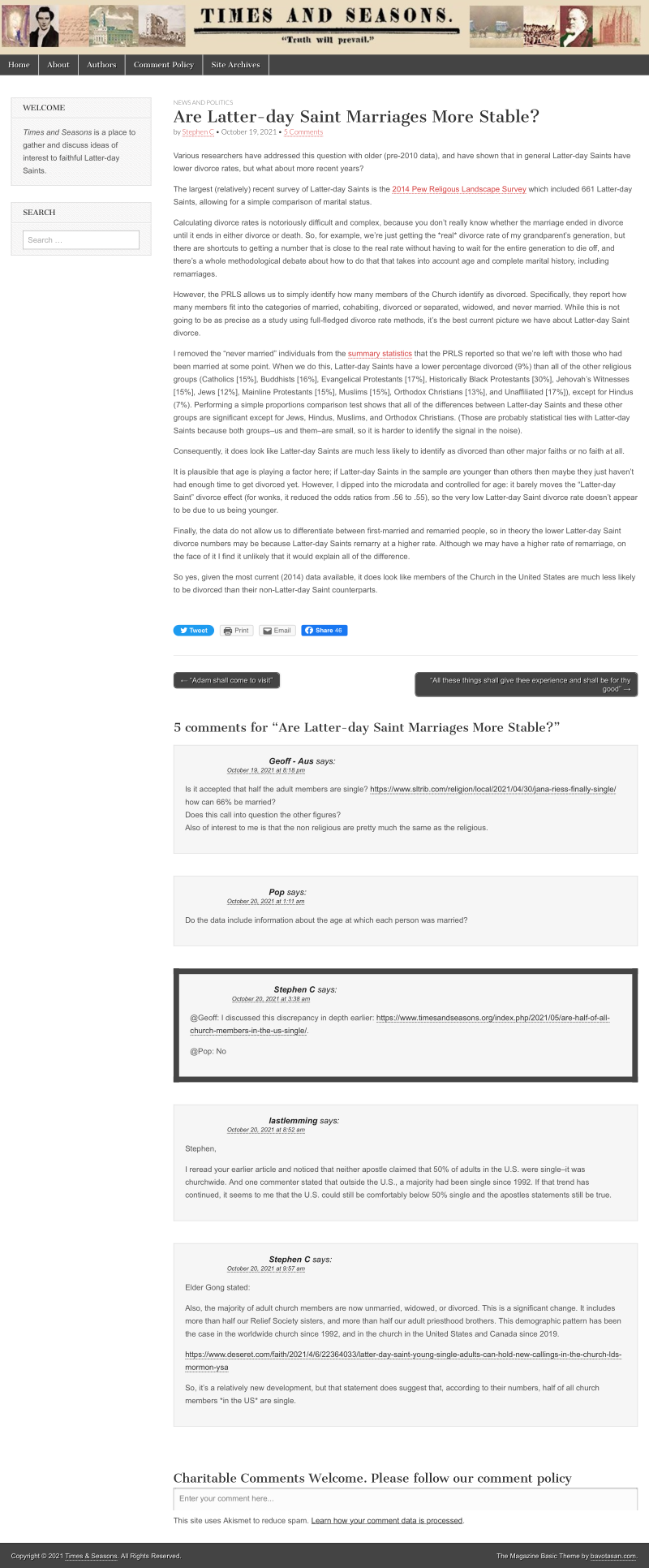Cranney analyzes Pew's 2014 data on Latter-day Saint divorce; LDS less likely to get divorced than non-LDS.
- Type
- Website
- Source
- N/A LDS
- Hearsay
- Secondary
- Reference
Stephen Cranney, "Are Latter-day Saint Marriages More Stable?" Times and Seasons blog, October 19, 2021, accessed October 25, 2021
- Scribe/Publisher
- Times and Seasons (blog)
- People
- N/A
- Audience
- Internet Public
- Transcription
Various researchers have addressed this question with older (pre-2010 data), and have shown that in general Latter-day Saints have lower divorce rates, but what about more recent years?
The largest (relatively) recent survey of Latter-day Saints is the 2014 Pew Religous Landscape Survey which included 661 Latter-day Saints, allowing for a simple comparison of marital status.
Calculating divorce rates is notoriously difficult and complex, because you don’t really know whether the marriage ended in divorce until it ends in either divorce or death. So, for example, we’re just getting the *real* divorce rate of my grandparent’s generation, but there are shortcuts to getting a number that is close to the real rate without having to wait for the entire generation to die off, and there’s a whole methodological debate about how to do that that takes into account age and complete marital history, including remarriages.
However, the PRLS allows us to simply identify how many members of the Church identify as divorced. Specifically, they report how many members fit into the categories of married, cohabiting, divorced or separated, widowed, and never married. While this is not going to be as precise as a study using full-fledged divorce rate methods, it’s the best current picture we have about Latter-day Saint divorce.
I removed the “never married” individuals from the summary statistics that the PRLS reported so that we’re left with those who had been married at some point. When we do this, Latter-day Saints have a lower percentage divorced (9%) than all of the other religious groups (Catholics [15%], Buddhists [16%], Evangelical Protestants [17%], Historically Black Protestants [30%], Jehovah’s Witnesses [15%], Jews [12%], Mainline Protestants [15%], Muslims [15%], Orthodox Christians [13%], and Unaffiliated [17%]), except for Hindus (7%). Performing a simple proportions comparison test shows that all of the differences between Latter-day Saints and these other groups are significant except for Jews, Hindus, Muslims, and Orthodox Christians. (Those are probably statistical ties with Latter-day Saints because both groups–us and them–are small, so it is harder to identify the signal in the noise).
Consequently, it does look like Latter-day Saints are much less likely to identify as divorced than other major faiths or no faith at all.
It is plausible that age is playing a factor here; if Latter-day Saints in the sample are younger than others then maybe they just haven’t had enough time to get divorced yet. However, I dipped into the microdata and controlled for age: it barely moves the “Latter-day Saint” divorce effect (for wonks, it reduced the odds ratios from .56 to .55), so the very low Latter-day Saint divorce rate doesn’t appear to be due to us being younger.
Finally, the data do not allow us to differentiate between first-married and remarried people, so in theory the lower Latter-day Saint divorce numbers may be because Latter-day Saints remarry at a higher rate. Although we may have a higher rate of remarriage, on the face of it I find it unlikely that it would explain all of the difference.
So yes, given the most current (2014) data available, it does look like members of the Church in the United States are much less likely to be divorced than their non-Latter-day Saint counterparts.
- BHR Staff Commentary
- Citations in Mormonr Qnas
The B. H. Roberts Foundation is not owned by, operated by, or affiliated with the Church of Jesus Christ of Latter-day Saints.

